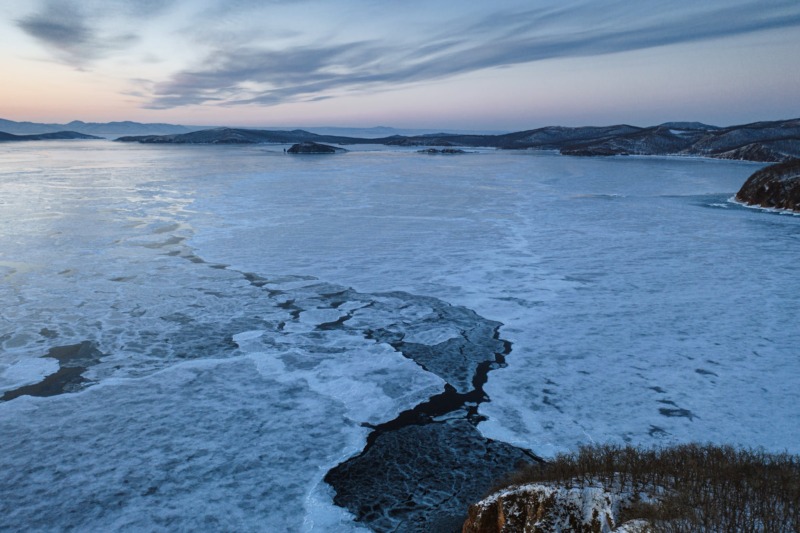[해외 DS] 북극해의 미래를 점치는 인공지능, “설명력 보완 필요해”
해빙 예측 연구에 적극적으로 활용된 인공지능 블랙박스 문제 남아 있어서 신뢰 못해 설명력과 예측력 모두 잡는 물리 기반 인공신경망
[해외DS]는 해외 유수의 데이터 사이언스 전문지들에서 전하는 업계 전문가들의 의견을 담았습니다. 저희 데이터 사이언스 경영 연구소 (GIAI R&D Korea)에서 영어 원문 공개 조건으로 콘텐츠 제휴가 진행 중입니다.

북극이사회에 따르면 2013년부터 2019년까지 북서항로를 통한 해상 교통량이 44% 증가했다. 막대한 천연자원 개발 잠재력으로 인해 이 지역에 관한 관심도 높아지고 있다. 따라서 특정 위치와 타이밍에 초점을 맞춰 해빙 면적을 예측할 수 있으면 해상 교통과 자원 개발에 큰 혜택을 가져다줄 수 있다. 하지만 지구 온난화로 해빙은 빠른 속도로 녹고 있다. NASA 기후변화 측은 10년 동안 북극의 바다 얼음은 약 12.85% 줄어든 것으로 나타났다고 보고했다. 기후 변화로 인해 이상 기후도 더 빈번하게 관측되며 해빙 예측의 불확실성도 덩달아 높아졌다.
기후변화에 빠르게 대응하고 정밀한 예측 수요를 위해 인공지능 모델 적용
통계적 모델링은 과거에 일어났던 일을 기반으로 미래를 예측하지만 불규칙한 기후 변화로 인해 예측 정확성이 점점 떨어지고 있다. 1970년대 후반부터 과학자들은 물리학 및 통계 모델링에 의존하여 해빙의 면적을 예측해 왔지만 전제 조건이 많이 필요한 기존의 방식으로는 실제 기후를 온전히 반영하지 못하는 단점이 있다. 전례 없는 속도로 얼음이 녹아 노출 표면이 넓어진 북극해는 더 많은 태양 빛을 흡수하게 됐다. 태양 빛을 반사해서 지구의 열을 식혀주던 북극 냉장고에 적신호가 켜졌다. 이런 상황에선 대략적인 패턴 파악보다 더 정밀한 예측이 필요하다.
바로 이 지점에서 인공지능의 역할이 강조됐다. 해빙 면적을 예측하는 데 AI를 사용하는 것은 새로운 접근 방식은 아니지만, 점점 더 주목받고 있다. “저희는 해양학 과학을 기반으로 북극을 위한 머신러닝 모델을 구축했습니다”라고 PolArtic 회사의 CEO 레슬리 카나베라(Leslie Canavera)는 말했다. 이 회사는 계절 예측과 운영 예측을 수행했는데, 계절 예측으로 13주 전에 선박 노선이 언제 개통될지 예측하고, 개통되는 날짜까지 예측할 수 있다고 주장했다. 아울러 운영 예측을 통해 해당 노선의 기상 조건도 함께 파악할 수 있다고 전했다. 영국 남극 조사소와 앨런 튜링 연구소가 함께 구성된 연구팀의 톰 앤더슨(Tom Anderson)은 자기 팀이 개발한 모델 IceNet이 두 달 앞서 95%의 정확도로 해빙을 예측할 수 있다고 말했다. 이는 슈퍼컴퓨터를 사용하는 물리 기반 모델을 능가하는 성능이고, 이후 하루 단위로 예측하는 모델을 개발해 급속한 해빙 손실을 지역사회에 알려주는 조기 경보 시스템으로 활용될 수도 있다고 강조했다.
블랙박스 문제 완화를 위해 물리 기반 인공신경망 활용
인공지능의 예측력이 높아도 설명력이 낮기 때문에 과학자들은 결과를 신뢰하기 어렵다고 입을 모았다. 의사 결정 과정이 투명하지 않고 때때로 잘못된 이유로 정답을 맞히는 경우도 발생하기 때문이다. 인공지능의 예측력과 물리·통계 모델의 설명력을 극대화하기 위해 물리 기반 인공신경망(Physics-informed neural networks)을 사용하는 사례가 늘고 있다. 일반적인 신경망은 학습 데이터만을 사용하여 학습하며 손실 함수는 관측값과 예측값의 간극을 최소화하도록 학습하는 반면, 물리 기반 인공신경망은 물리 방정식 자체를 손실 함수에 적용하여 데이터가 물리 법칙을 만족하도록 학습이 진행된다. 사전에 알려진 물리적 지식을 기계학습 알고리즘에 통합함으로써 알고리즘의 의사결정이 물리적 현상을 위배하지 않도록 규제하는 기법이다.
전통적인 계산 방법이 물리 기반 인공신경망에 비해 느리지만 정확도가 높기 때문에 전통적인 수치해석 법을 기본적으로 채택하고 시간이 오래 걸리는 계산만 신경망으로 대체하는 전략이 하나 있다. 또는 물리 정보 신경망의 빠른 시뮬레이션 속도를 이용하여 근사치까지 신경망으로 계산한 후 더 정확한 계산을 위해 전통적인 수치해석 방법을 사용하는 구조도 있다. 인공지능을 사용하여 물리 기반 모델을 개선함으로써 기후와 해빙 시스템이 수십 년, 수백 년 단위로 어떻게 변화할지 예측할 방법을 과학자들은 모색하고 있다. 한편 국내 해양수산부와 극지연구소는 북극 해빙의 두께를 추정하는 새로운 기술을 ‘대기와 해양기술’ 국제 학술지에 게재했다. 해빙의 두께에 따라 녹는 속도가 달라지기 때문에 두께 정보는 해빙의 변화 분석에 핵심 요소다. 기존의 위성에서 확보한 자료에도 해당 추정 방법을 적용할 수 있어서 해빙의 변화 흐름을 더 완전하게 설명할 수 있을 것으로 기대감을 모았다.
As Arctic Sea Ice Breaks Up, AI Is Starting to Predict Where the Ice Will Go
Sea ice is changing fast. Are forecasts, created by artificial intelligence, the best way to keep up with the pace of a warming climate in the far north?
Emily Schwing: In October 2019 an international team of scientists onboard an icebreaker intentionally let Arctic Sea ice freeze up around the ship. They wante d to learn more about the ice itself. But in April 2020, just halfway through the year-long experiment, it was unclear if that ice would stay frozen for the remaining six months of the project.
Schwing: You’re listening to Scientific American’s Science, Quickly. I’m Emily Schwing.
Sea ice, according to scientists, is melting at an alarming rate—so quickly that some researchers believe traditional methods for forecasting its extent may not keep up with the pace of a changing climate.
By the year 2050, the Arctic could be ice-free in the summer months. And shipping traffic in the region is on the rise, but predicting sea ice extent is complicated.
Today we’re looking at how machine learning—artificial intelligence—could become the tool of the future for sea ice forecasting.
Leslie Canavera: We build artificial intelligence and machine learning models for the Arctic, based on the science of oceanography.
Schwing: That’s Leslie Canavera. She is CEO of a company called PolArctic, and she is trying to forecast ice in a different way than science ever has.
Since the late 1970s, scientists have relied on physics and statistical modeling to create sea ice forecasts.
Canavera: When you take two water molecules, and you freeze them together, you know, like, right, this is how they freeze together. But there’s a lot of assumptions in that. And when you extrapolate to the ocean, there’s a lot of error…. And statistical modeling is based on, like, historical things of what’s happened. But with climate change, it’s not acting like the history anymore. And so artificial intelligence really takes the best of both of those and is able to learn the system and trends to be able to forecast that more accurately.
Schwing: Of course, that foundation of statistics and historical data is still important, even with its errors and caveats.
Holland: We can’t model every centimeter of the globe.
Schwing: Marika Holland is a scientist at the National Center for Atmospheric Research in Boulder, Colorado. The center has been using physics and statistical modeling to predict sea ice extent for the past five decades. Holland says that she is confident in the methodology but that these forecasts aren’t perfect.
Holland: You know, we have to kind of coarsen things, and so we get a little bit of a muddy picture of how the sea ice cover is changing or how aspects of the climate or the Earth’s system are evolving over time.
Schwing: Marika says there are also a lot of smaller-scale processes that can create problems for accurate forecasting.
Holland: Something like the snow cover on the sea ice, which can be really heterogeneous, and that snow is really insulating, it can affect how much heat gets through the ice…. We have to approximate those things because we aren’t going to resolve every centimeter of snow on the sea ice, for example…. So there’s always room for improvement in these systems.
Schwing: It’s that space—the room for improvement—where Leslie says artificial intelligence can be most helpful. And that help is especially important right now because of what is happening in the Arctic.
According to the Arctic Council, marine traffic increased by 44 percent through the Northwest Passage between 2013 and 2019. Search-and-rescue capabilities in the region are limited, and there has been increased attention on the region for its vast natural resource development potential. Leslie says AI can create a forecast on a smaller scale, homing in on specific locations and timing to benefit those user groups.
Canavera : We did a seasonal forecast and then an operational forecast where the seasonal forecast was 13 weeks in advance. We were able to forecast when their route would be open…, and we were actually to the day on when the route would be able to be open and they would be able to go. And then we did operational forecasts where it was like,“All right, you’re in the route, what [are] the weather conditions kind of looking like?”
Schwing: Using AI to forecast sea ice extent isn’t a novel approach, but it is gaining traction. A team led by the British Antarctic Survey’s Tom Anderson published a study two years ago in the journal Nature Communications. In a YouTube video that year, Tom touted the benefits of his team’s model, called IceNet.
[CLIP: Anderson speaks in YouTube video: “What we found is super surprising. IceNet actually outperformed one of the leading physics-based models in these long-range sea ice forecasts of two months and beyond while also running thousands of times faster. So IceNet could run on a laptop while previous physics-based methods would have to run for hours on a supercomputer to produce the same forecasts.”]
Schwing: One of the biggest limitations when it comes to AI-generated sea ice forecasts is what Leslie calls “the black box.”
Canavera: And you have all of this data. You put it into the artificial intelligence black box, and then you get the answer. And the answer is right. And scientists get very frustrated because they’re like, “Well, tell me what the black box did,” right? And you’re like, “Well, it gave you the right answer.” And so there’s a big trend in artificial intelligence that is called XAI, and explainable AI si hwat that kind of relates to and “Why did your artificial intelligence give you the right answer?”
Sometimes, she says, AI happens upon the right answer but for the wrong reasons. That’s why Marika at the National Center for Atmospheric Research says the most effective sea ice forecasts are likely to come from combining both machine learning and five decades’ worth of physics and statistical modeling.
Holland: If machine learning can help to improve those physics-based models, that’s wonderful. And that is kind of the avenues that we’re exploring—is how to use machine learning to improve these physics-based models that then allow us to kind of predict how the climate and the sea ice system are going to change on decadal, multidecadal [kinds] of timescales.
Schwing: And there’s one piece of the sea ice forecasting puzzle Leslie, who is Alaska Native, believes is irreplaceable: traditional Indigenous knowledge.
Canavera: What’s great about traditional Indigenous knowledge and artificial intelligence is that a lot of traditional Indigenous knowledge is data, and artificial intelligence builds models on data. And that’s why it works better than these like dynamical models in being able to incorporate the traditional Indigenous knowledge.
For Science, Quickly, I’m Emily Schwing.
Scientific American’s Science, Quickly is produced and edited by Tulika Bose, Jeff DelViscio and Kelso Harper. Our theme music was composed by Dominic Smith.
You can listen to Science, Quickly wherever you get your podcasts. For more up-to-date and in-depth science news, head to ScientificAmerican.com. Thanks, and see you next time.



























